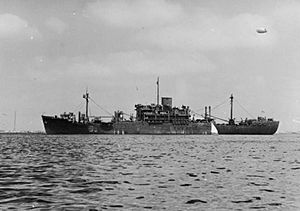Raid on Bardia facts for kids
Quick facts for kids Raid on Bardia |
|||||||
|---|---|---|---|---|---|---|---|
| Part of the Siege of Tobruk, during the Second World War | |||||||
 British commandos in landing craft |
|||||||
|
|||||||
| Belligerents | |||||||
| Commanders and leaders | |||||||
| Strength | |||||||
| A Battalion Layforce RTR Troop HMS Glengyle HMS Coventry HMAS Stuart HMAS Voyager HMAS Waterhen HMS Triumph |
|||||||
| Casualties and losses | |||||||
| 1 killed 70 captured |
1 artillery battery destroyed 1 supply dump destroyed |
||||||
The Raid on Bardia was a surprise attack by sea on the town of Bardia in North Africa. It happened during the night of April 19-20, 1941, in World War II. British special forces, called British Commandos, carried out the raid.
The attack was done by a group called No. 7 Commando, also known as A Battalion Layforce. They had help from a small team with tanks from the Royal Tank Regiment. Five navy ships and a submarine supported the raiders from the sea. The mission successfully destroyed an Italian artillery battery (a group of big guns) and a supply area. Even though 71 men were lost, the raid was seen as a success. A big result of the raid was that it made the Germans move some of their tanks away from the main battle to protect areas behind their lines.
Contents
Why the Raid Happened
In January 1941, a special group of 2,000 commandos, known as Layforce, was sent from Great Britain. Their job was to carry out surprise attacks in the Mediterranean Sea area. This force was led by Colonel Robert Laycock.
When Layforce arrived in Egypt in March 1941, more soldiers joined them. To keep their arrival a secret from the Axis powers (Germany and Italy), the commando groups were given new names like A, B, C, and D Battalions Layforce.
Setting the Scene: The War in North Africa
In early 1941, British and Commonwealth forces won a big victory against Italian troops in North Africa. However, many British soldiers were then sent to Greece to help there.
Adolf Hitler, the leader of Germany, sent new German troops called the Afrika Korps to North Africa. This was to help the Italians and stop them from losing more ground. The Afrika Korps had fresh soldiers, better equipment, and strong tanks. They were led by a famous general named Erwin Rommel.
The German and Italian forces quickly pushed the British back. By April 15, they had surrounded the British at Tobruk. Several British commanders were captured. The British forces were struggling, with many tanks broken down. A battle line formed near the border with Egypt. Because of this, the plans for Layforce changed, and their first mission became the raid on Bardia.
The Raid on Bardia
The Bardia raid was planned for the night of April 19-20. The goal for A Battalion, Layforce, was to cause as much damage as possible to enemy bases and equipment. The plan was for the commandos and a small group of tanks to land on four different beaches at the same time. They would use special landing boats called Landing Craft Assault (LCA).
The main ship carrying the landing force was HMS Glengyle. It was protected by other navy ships: HMS Coventry, HMAS Stuart, Voyager, and Waterhen.
Near Bardia, there were problems getting the landing boats into the water. When they finally got going, they were late and landed on the wrong beaches. The commandos expected to see guiding lights, but these lights were supposed to be set up by another team. That team was delayed when the submarine carrying them, HMS Triumph, had to dive to avoid friendly fire.
Despite the delays and landing in the wrong spots, the commandos landed without any fighting. They moved inland to destroy their targets. They found that Bardia had no Italian or German soldiers. Some targets were missed because the information they had was wrong. The targets were either not where they were supposed to be or didn't exist.
However, the commandos did manage to destroy an Italian supply area and an Italian coastal artillery battery. After completing their mission, they returned to their landing boats to leave. The raid would have had no losses for the commandos, except for one officer who was accidentally killed by friendly fire. Also, 70 men got lost and ended up on the wrong beach for pickup. They were captured and became prisoners of war.
What Happened After
The author Evelyn Waugh, who was part of the raid, wrote about it in a magazine. He said that the Germans sent many tanks to fight what they thought was a big invasion. However, in his diary, which was published later, he described a different story. He wrote that the commandos had problems, but there was almost no enemy resistance.
See also
- List of British military equipment of World War II
- List of German military equipment of World War II
- List of Italian military equipment in World War II


